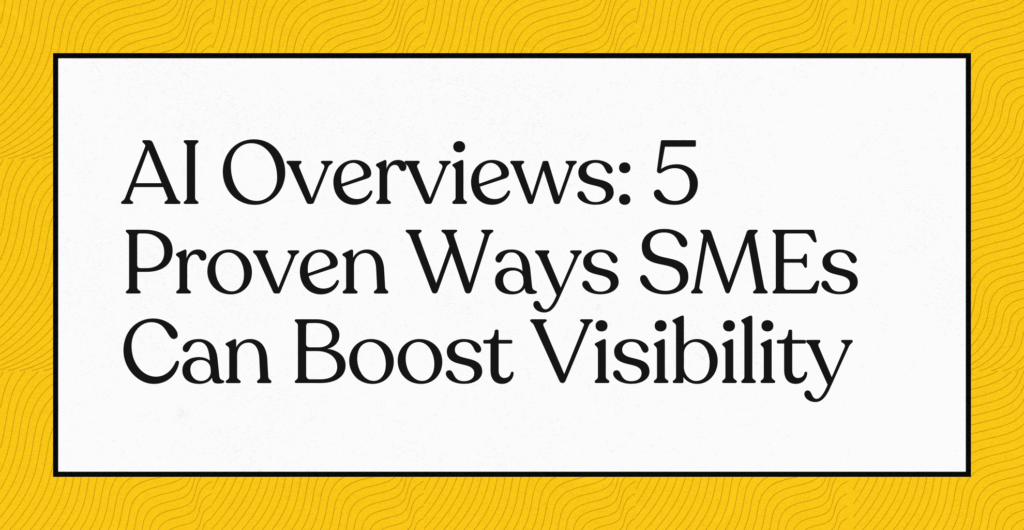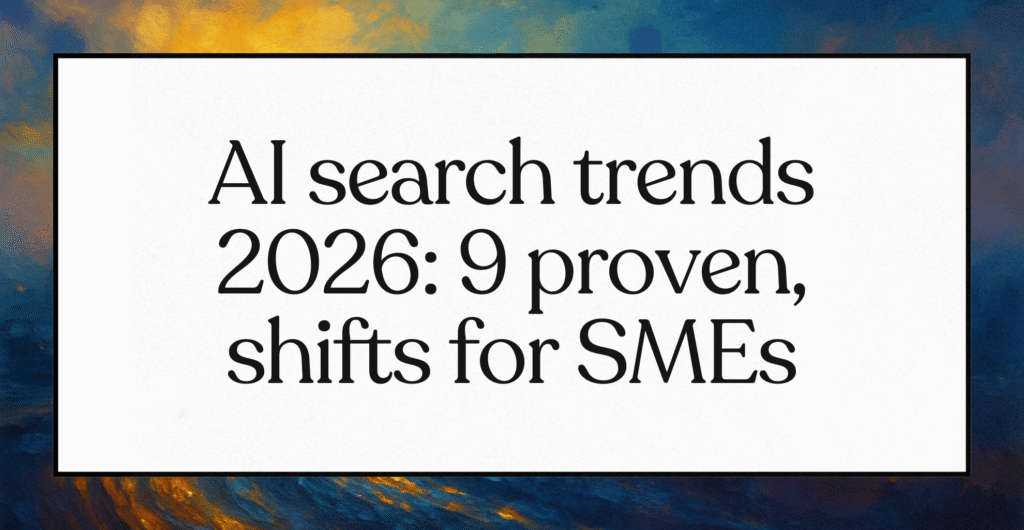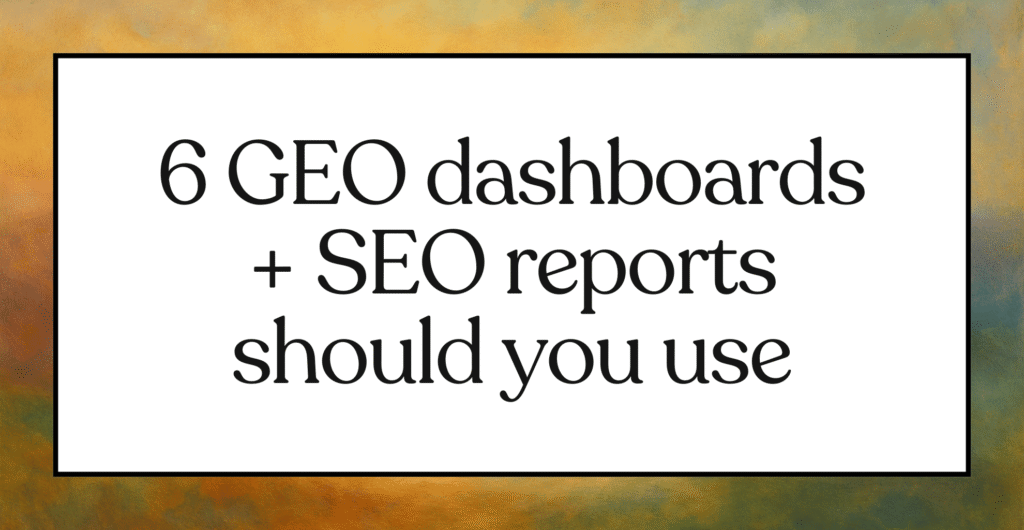With Google’s AI Overviews now appearing in over 40% of local business searches and AI-powered platforms processing billions of queries monthly, small and medium enterprises (SMEs) face an unprecedented challenge: how to remain visible when AI Overviews and similar systems increasingly control what customers see. This transformation represents both the greatest threat and the most significant opportunity SMEs have encountered in decades. While traditional SEO tactics focused on climbing search rankings, the new paradigm demands that businesses become the trusted sources AI Overviews and other AI systems choose to cite and recommend.
AI Overviews and Their Growing Impact on SME Visibility
AI Overviews represent Google’s most significant search innovation since the introduction of featured snippets. These AI-generated summaries appear at the top of search results pages, providing users with instant, authoritative answers to their queries without requiring them to click through to individual websites. For SMEs, this development creates a fundamental shift in how customers discover and interact with businesses online.
The numbers tell a compelling story about the rapid adoption of AI-powered search features. According to recent data from SE Ranking, 47% of keywords now trigger AI Overviews, representing a 5% increase since July 2024. Even more significant for small businesses is the fact that 52% of sources appearing in AI Overviews rank within the top 10 traditional search results, with an average position of 4.6. This suggests that while AI Overviews are reshaping visibility, they still draw from content that demonstrates strong SEO fundamentals.
The implications for SME visibility extend far beyond simple traffic metrics. Research conducted by Local Falcon reveals that AI Overviews appear in 40.2% of local business searches, with informational queries (58.3%) and reason-based queries (59.9%) significantly more likely to trigger these features than commercial queries (17.2%). This pattern creates both challenges and opportunities for SMEs: while direct commercial searches may see less AI intervention, businesses must now compete for visibility in the educational and informational content space that drives customer awareness and consideration.
For African SMEs specifically, this shift occurs against a backdrop of accelerating digital transformation. With only 28% of Africa’s population having access to reliable internet connectivity and a shortage of approximately 230 million digital jobs according to the African Union, the AI Overviews phenomenon creates both urgency and opportunity. SMEs that master AI visibility strategies now can establish competitive advantages that transcend traditional geographic and resource limitations.
The experience of businesses already navigating this transition provides valuable insights. Andrew Shotland, founder of Local SEO Guide, reports observing traffic declines for small businesses that have historically relied on educational content to attract potential customers. One law firm client that previously received substantial traffic from searches like “Is car sex legal in Alabama?” now finds that AI Overviews provide direct answers, reducing click-through rates despite the firm still appearing in traditional search results.
However, this shift isn’t universally negative for SMEs. Greenlight Designs documented a case where a Malaysian B2B software firm lost 18% of organic clicks but increased qualified leads by 31% after their FAQ and service pages began appearing in AI-generated answers. This suggests that while AI Overviews may reduce overall website traffic, they can drive higher-quality, more engaged prospects who are further along in their decision-making process.
The Current Reality: How AI Overviews Are Reshaping Search for Small Businesses
The transformation of search behavior through AI Overviews creates what industry experts describe as a “zero-click search” environment. Recent analysis from BrightEdge shows that while Google search impressions increased by 49% year-over-year, click-through rates dropped by 30%. This dramatic shift represents a fundamental change in how users interact with search results, with many queries now resolved entirely within the search results page through AI-generated summaries.
The impact varies significantly by query type and business category. Local businesses serving immediate needs – such as restaurants, plumbers, or emergency services – continue to benefit from location-based searches that prioritize direct contact and navigation. However, businesses that rely on educational content marketing to attract customers face the most significant challenges, as AI Overviews increasingly satisfy informational queries without generating website visits.
SMEs operating in knowledge-intensive sectors experience this shift most acutely. Consultancies, legal practices, healthcare providers, and professional services firms that have traditionally used blog content, guides, and educational resources to demonstrate expertise now find their carefully crafted content summarized and presented without attribution to the original source. This phenomenon forces a fundamental reconsideration of content strategy and customer acquisition approaches.
The geographic dimension of AI Overviews adoption reveals important patterns for SME strategy. Data from Local Falcon’s comprehensive analysis shows that queries including specific location names have significantly lower AI Overviews appearance rates (35.0%) compared to non-location-specific queries (46.1%). This geographic advantage suggests that SMEs with strong local optimization may maintain better traditional search visibility while still needing to adapt to AI-driven changes in broader market awareness and education queries.
The competitive landscape implications extend beyond simple visibility metrics. SMEs now compete not just with other local businesses, but with global brands and AI-optimized content for inclusion in AI-generated responses. This democratization of information access creates opportunities for well-positioned small businesses to appear alongside major corporations in AI Overviews, provided they understand and implement appropriate optimization strategies.
Current data suggests that businesses appearing in AI Overviews often experience what researchers term “quality traffic concentration.” While overall visitor numbers may decline, the traffic that does convert demonstrates higher engagement rates, longer session durations, and better conversion rates. This pattern indicates that AI Overviews may actually improve lead quality by pre-qualifying prospects who click through after receiving initial information from AI summaries.
Step 1: Build E-E-A-T Foundations That AI Systems Trust
Experience, Expertise, Authoritativeness, and Trustworthiness (E-E-A-T) represents Google’s core framework for evaluating content quality, and these principles have become even more critical in the AI-first search environment. AI systems prioritize content from sources they can verify as credible, making E-E-A-T the fundamental building block for any SME seeking AI Overviews inclusion.
The “Experience” component, added to Google’s guidelines in December 2022, emphasizes first-hand knowledge and practical insights. For SMEs, this creates a significant competitive advantage over larger corporations that may lack direct, personal experience in local markets or specialized niches. African SMEs, in particular, can leverage their deep understanding of local conditions, cultural contexts, and market-specific challenges to demonstrate experience that multinational competitors cannot match.
Building demonstrable expertise requires systematic documentation of knowledge and credentials. SMEs should prominently display team qualifications, professional certifications, industry memberships, and relevant achievements on their websites. For professional services firms, this includes showcasing continuing education, speaking engagements, published research, or case study outcomes. Manufacturing or retail businesses can highlight years of operation, customer testimonials, and specialized product knowledge.
Authoritativeness extends beyond individual expertise to encompass brand recognition within specific industries or geographic regions. SMEs can build authority through strategic partnerships with established local organizations, participation in industry associations, and consistent contribution to relevant professional discussions. For African SMEs, this might include collaboration with regional trade organizations, participation in local economic development initiatives, or contribution to industry publications focused on emerging markets.
Trustworthiness manifests through transparency, security, and reliability indicators that AI systems can verify automatically. Essential trust signals include secure website hosting (HTTPS), clear contact information, transparent business registration details, and consistent online presence across platforms. SMEs must ensure their business information remains consistent across Google Business Profile, social media platforms, industry directories, and their main website.
The implementation of E-E-A-T principles requires ongoing content strategy alignment. Rather than simply claiming expertise, SMEs must demonstrate it through regular publication of insights, analysis, and guidance relevant to their target audiences. This content should reflect genuine experience, cite authoritative sources where appropriate, and provide actionable value that competitors cannot easily replicate.
For local service businesses, E-E-A-T development might involve creating detailed case studies showing problem-solving approaches, publishing guides that reflect local market conditions, or sharing insights about regulatory changes affecting their industry. Professional services firms can build E-E-A-T through thought leadership content that demonstrates deep understanding of client challenges and emerging trends within their practice areas.
Technical implementation of E-E-A-T signals involves structured data markup that helps AI systems identify and verify credibility indicators. This includes author schema markup that connects content to verified professional profiles, organization schema that establishes business legitimacy, and review schema that showcases customer feedback and ratings.
Step 2: Structure Your Content for AI Readability and Understanding
AI systems process content fundamentally differently than human readers, requiring SMEs to adopt new approaches to information architecture and presentation. While human readers can interpret context, infer meaning, and navigate complex formatting, AI systems rely on clear structural signals and explicit semantic relationships to understand and extract information effectively.
The foundation of AI-readable content lies in hierarchical organization using proper heading structures (H1, H2, H3) that create logical information flows. Each heading should function as a mini-topic sentence that clearly signals the content’s focus, while subsequent paragraphs provide supporting details in logical progression. This approach enables AI systems to quickly identify key concepts and their relationships within the broader content framework.
Question-based formatting represents one of the most effective strategies for AI optimization. Content structured around explicit questions that match common user queries increases the likelihood of AI inclusion significantly. SMEs should research the specific questions their target customers ask using tools like AnswerThePublic, AlsoAsked, or customer service logs, then create content sections that directly address these inquiries with clear, concise answers followed by detailed explanations.
The implementation of “TL;DR” (Too Long; Didn’t Read) summaries at the beginning of content sections provides AI systems with easily extractable key points. These summaries should capture the essential information in 2-3 sentences, using natural language that mirrors how customers might phrase related questions. This approach serves dual purposes: improving AI comprehension while enhancing user experience for human readers seeking quick information.
List-based content formatting significantly increases AI citation potential. Information presented in numbered or bulleted lists enables AI systems to extract specific points for inclusion in generated responses. SMEs should structure procedural information, feature comparisons, benefits lists, and step-by-step guides using clear list formatting with descriptive headings that facilitate AI parsing.
Content depth requirements for AI optimization differ from traditional SEO approaches. While traditional SEO often rewards longer content, AI systems prioritize comprehensive coverage of topics with clear, authoritative information over simple word count. SMEs should focus on providing complete answers to customer questions while maintaining readability and avoiding unnecessary elaboration that might confuse AI parsing algorithms.
The integration of semantic markup within content helps AI systems understand relationships between concepts, entities, and topics. This involves using consistent terminology for key business concepts, products, or services throughout content, while also incorporating related terms and synonyms that reflect natural language variations customers might use when searching or asking questions.
Internal linking strategies for AI optimization should focus on creating clear topical relationships between related content pieces. Rather than random cross-linking, SMEs should develop content clusters around core topics, with internal links that guide both AI systems and human readers through logical information progressions that demonstrate comprehensive expertise in specific subject areas.
Step 3: Optimize Local Business Information Across All Digital Touchpoints
Consistency in business information represents one of the most critical factors for AI system trust and local search visibility. AI algorithms cross-reference business details across multiple platforms to verify authenticity and reliability, making inconsistent information a significant barrier to AI Overviews inclusion. SMEs must ensure their business name, address, phone number (NAP), hours, and service descriptions remain identical across all digital touchpoints.
Google Business Profile optimization forms the cornerstone of local AI visibility strategy. Complete profile information with detailed business descriptions, comprehensive service lists, high-quality photos, and regular updates signals authority to AI systems. SMEs should upload photos showing their team, workspace, products, and satisfied customers in action, as AI systems increasingly incorporate visual context when generating local business recommendations.
The expansion of local business information beyond basic NAP data significantly improves AI understanding and citation potential. This includes detailed service area descriptions, specific industry specializations, pricing information where appropriate, and clear explanations of what makes the business unique within its local market. For African SMEs, this might involve highlighting expertise in local regulations, cultural considerations, or region-specific challenges that international competitors cannot address.
Review management strategy requires particular attention in the AI era, as AI systems analyze review content for context, specific details, and authentic language patterns. Generic five-star reviews carry less weight than detailed feedback that explains specific customer experiences, challenges addressed, and outcomes achieved. SMEs should encourage customers to provide specific details about services received, problems solved, and the quality of their experience.
Response strategy for customer reviews becomes part of the overall AI visibility approach. AI systems analyze business owner responses to evaluate customer service quality and problem-resolution approaches. Responses should demonstrate genuine engagement with customer feedback, provide helpful information for future customers, and showcase the business’s commitment to customer satisfaction and continuous improvement.
Local content creation should reflect genuine geographic expertise and community involvement. Rather than generic business content, SMEs should create location-specific resources that address local market conditions, regulatory requirements, seasonal considerations, and community events. This approach signals to AI systems that the business possesses authentic local knowledge that competitors from other regions cannot replicate.
Citation building for AI optimization focuses on quality over quantity, emphasizing high-authority local directories, industry-specific platforms, and community websites where target customers actually spend time. AI systems evaluate citation source credibility when determining business trustworthiness, making strategic citation placement more important than simple citation volume.
The integration of local schema markup helps AI systems understand geographic service areas, business categories, and location-specific offerings. This structured data should clearly indicate service territories, branch locations if applicable, and any geographic limitations or specializations that define the business’s market focus.
Step 4: Create Question-Focused Content That Answers Real Customer Queries
Question-based content strategy offers the clearest path to AI Overviews inclusion, as generative systems prioritize content that answers user queries directly. SMEs should shift from keyword-focused writing to anticipating and addressing real customer questions at each decision stage.
Identifying these questions requires mixed inputs: customer service logs, sales feedback, social media interactions, surveys, and external tools like AnswerThePublic or Google’s People Also Ask. This ensures coverage of authentic concerns and common variations relevant to AI Overviews.
Content should use clear question headlines followed by concise, actionable answers within the first lines, then expand with examples and context. This structure helps AI extract key points quickly and improves the chance of being surfaced in AI Overviews.
FAQ sections strengthen both user experience and AI citation potential. They should cover not only business basics but also pricing, processes, timelines, and post-service support—elements that boost visibility in AI Overviews.
Industry focus matters: professional services should highlight qualifications, methods, and fees; retail must address comparisons, warranties, and returns; local providers should explain coverage areas, licensing, and availability. Aligning these with real search phrasing further increases AI Overviews relevance.
Depth is essential: answers must be comprehensive enough to remove the need for further searches. Using conversational patterns and regional variations ensures alignment with how customers ask questions, improving AI comprehension and AI Overviews inclusion.
Finally, SMEs must maintain freshness by monitoring inquiries, industry updates, and competitor moves. Regularly refreshing question-based content keeps it accurate, relevant, and consistently selected for AI Overviews.
Step 5: Implement Strategic Schema Markup for Enhanced AI Recognition
Schema markup implementation provides the clearest communication pathway between SME websites and AI systems, creating structured data that algorithms can parse, understand, and incorporate into generated responses. This technical foundation enables AI systems to accurately identify business information, service offerings, and content topics with the precision necessary for confident citation and recommendation, which is increasingly critical for visibility in AI Overviews.
The selection of appropriate schema types depends on business model and primary customer touchpoints. Local service businesses benefit most from LocalBusiness schema, Organization schema, and Service schema markup. Professional services firms should implement Person schema for key team members, ProfessionalService schema for offerings, and Review schema for client feedback. Retail businesses require Product schema, Offer schema, and AggregateRating schema to communicate inventory and customer satisfaction data effectively, making their presence in AI Overviews more likely.
JSON-LD format represents the preferred implementation approach for most SMEs due to its simplicity and Google’s explicit recommendation. Unlike microdata or RDFa formats that require integration throughout HTML content, JSON-LD can be added to website headers as standalone code blocks, making implementation more manageable for businesses without extensive technical resources while improving the chances of inclusion in AI Overviews.
FAQ schema markup creates particularly strong opportunities for AI Overviews inclusion by providing structured question-and-answer pairs that AI systems can readily extract and present. SMEs should implement FAQ schema on pages containing common customer questions, with each FAQ entry including the question text and complete answer content formatted according to schema.org specifications to align with AI Overviews requirements.
Service schema implementation should include detailed descriptions of offerings, service areas, and typical project timelines where applicable. This markup helps AI systems understand business capabilities and recommend appropriate providers when users ask questions about specific services or geographic coverage areas. For African SMEs, service schema can highlight local expertise, regional specializations, and cultural competencies that stand out in AI Overviews compared to international competitors.
Review and rating schema markup aggregates customer feedback data in formats that AI systems can easily interpret and incorporate into business recommendations. This structured data should include review text, numerical ratings, reviewer information, and date stamps to provide comprehensive feedback context that enhances business credibility within AI Overviews and other AI-generated responses.
Implementation validation requires systematic testing to ensure schema markup functions correctly and provides the intended information to AI systems. Google’s Rich Results Test and Schema Markup Validator tools identify technical errors, missing properties, and optimization opportunities. SMEs should test schema implementation regularly, particularly after website updates or content changes that might affect structured data integrity, as errors could reduce their visibility in AI Overviews.
Ongoing schema maintenance involves updating structured data as business information, services, or customer feedback evolve. Schema markup requires the same attention to accuracy and freshness as other business information, with regular audits to ensure continued effectiveness in supporting AI system understanding and citation of business information, thereby strengthening presence in AI Overviews over time.
Measuring Success: Tracking Your AI Visibility Performance
Performance measurement for AI Overviews optimization requires new metrics and monitoring approaches that extend beyond traditional SEO analytics. SMEs must track both direct AI citation occurrences and indirect indicators of improved AI system trust and recognition. This comprehensive measurement approach enables data-driven optimization and demonstrates return on investment for AI visibility initiatives.
Direct AI citation tracking involves systematically monitoring when business information, content, or recommendations appear within AI-generated responses across major platforms. SMEs should conduct regular searches for key terms related to their business, services, and expertise areas using ChatGPT, Perplexity, Google AI Overviews, and Bing Copilot to document citation frequency and context. This manual monitoring should be supplemented with automated tools where available to ensure comprehensive coverage.
Google Search Console provides valuable insights into AI Overviews performance through impressions and click data for queries that trigger AI-powered features. SMEs should monitor changes in impression share, click-through rates, and query patterns to understand how AI Overviews affect their search visibility. Particular attention should be paid to informational queries where AI Overviews are most likely to appear and impact traditional search traffic.
Local visibility metrics require monitoring across Google Business Profile insights, local directory performance, and geographic search result tracking. SMEs should track changes in local search impressions, customer actions (calls, website visits, direction requests), and review acquisition rates as indicators of improved AI system recognition and recommendation frequency.
Content performance analysis should focus on pages and topics that demonstrate strong AI citation potential. Metrics include time spent on page, bounce rates, conversion rates, and lead quality from organic search traffic. As AI Overviews may reduce overall traffic while improving lead quality, SMEs must balance volume metrics with engagement and conversion indicators to assess true performance impact.
Competitive analysis for AI visibility involves monitoring when competitors appear in AI-generated responses for relevant queries and identifying content gaps or optimization opportunities. SMEs should track competitor citation frequency, analyze the content types that generate AI inclusion, and develop strategies to create more comprehensive, authoritative content in areas where competitors demonstrate AI visibility success.
Technical performance monitoring includes schema markup validation, site speed optimization, mobile responsiveness, and security certificate maintenance – all factors that influence AI system trust and citation likelihood. Regular technical audits ensure that optimization efforts remain effective as search algorithms and AI systems evolve.
Long-term trend analysis should examine the relationship between AI optimization efforts and business outcomes including lead generation, customer acquisition, and revenue growth. SMEs should establish baseline measurements before implementing AI optimization strategies, then track improvements over quarterly and annual periods to demonstrate ROI and guide continued investment in AI visibility initiatives.
Special Considerations for African SMEs in the AI-First Era
African SMEs operate within a unique digital transformation context that creates both distinct challenges and exceptional opportunities in the AI-first search environment shaped by AI Overviews. While infrastructure limitations and resource constraints present obstacles, the rapid adoption of mobile technology and localized digital solutions provides pathways for competitive advantage that international competitors cannot easily replicate, especially when AI Overviews highlight regional strengths.
Digital infrastructure realities significantly impact AI optimization strategies for African SMEs. With only 28% of Africa’s population having reliable internet access and frequent power outages affecting online presence consistency, businesses must prioritize mobile-first optimization and offline-to-online integration strategies. This includes ensuring websites load quickly on slower connections, implementing progressive web app features where possible, and maintaining consistent business information even during connectivity interruptions so AI Overviews can present accurate results.
Mobile-first AI optimization takes on particular importance given that mobile money platforms like M-Pesa, Orange Money, and EcoCash have created thriving digital ecosystems across countries like Kenya, Ghana, Nigeria, and South Africa. SMEs should ensure their AI optimization efforts align with mobile search behaviors and integrate seamlessly with mobile payment systems that customers already trust and use regularly, which also improves visibility in AI Overviews.
Local expertise positioning represents a significant competitive advantage for African SMEs in AI search results. While international competitors may offer similar products or services, African businesses possess irreplaceable knowledge about local regulations, cultural considerations, seasonal business patterns, and region-specific challenges. Content strategy should explicitly highlight this local expertise through case studies, regulatory guidance, and cultural insights that AI Overviews can recognize and cite when users seek locally relevant information.
Language and cultural optimization requires attention to multiple linguistic contexts within individual African markets. SMEs should create content that reflects local language variations, cultural references, and communication styles that resonate with target audiences while remaining accessible to AI systems trained primarily on global English content. This balance ensures both local relevance and comprehension by systems powering AI Overviews.
Resource optimization strategies must acknowledge the financial and technical constraints many African SMEs face while maximizing AI visibility impact. Priority should be given to high-impact, low-cost optimization activities such as Google Business Profile completion, basic schema markup implementation, and question-focused content creation using free tools and platforms. These measures increase the likelihood of inclusion in AI Overviews while keeping costs low. Investment in more sophisticated optimization techniques can follow as businesses grow and generate returns from initial visibility efforts.
Partnership and collaboration opportunities within African business ecosystems can amplify individual SME visibility. Industry associations, local business networks, and regional trade organizations provide platforms for shared learning, resource pooling, and collective visibility initiatives that individual businesses might not achieve independently. These collaborations can include shared content creation, cross-referencing, and mutual citation strategies that increase representation in AI Overviews.
Government policy alignment presents both opportunities and requirements for African SMEs pursuing AI optimization. As governments across the continent develop digital transformation policies and support programs, businesses should ensure their strategies align with national digitization initiatives while taking advantage of available support resources, training programs, and funding opportunities that improve recognition by AI Overviews.
Success measurement for African SMEs should account for regional market conditions, seasonal business patterns, and local customer behavior differences. Metrics should reflect not just international AI platform citation but also performance within regional search patterns, local directory visibility, and integration with African e-commerce platforms like Jumia. These factors influence whether businesses are prominently featured in AI Overviews, driving both local and global reach.
Conclusion
The emergence of AI Overviews fundamentally transforms how SMEs must approach digital visibility, creating both unprecedented challenges and remarkable opportunities for businesses willing to adapt their strategies. The five steps outlined – building E-E-A-T foundations, structuring content for AI readability, optimizing local business information, creating question-focused content, and implementing strategic schema markup – provide a comprehensive framework for SMEs to compete effectively in the AI-first search environment.
The evidence demonstrates that SMEs possess unique advantages in this new landscape. Their deep local expertise, direct customer relationships, and agility in adapting to market changes position them well to create the authentic, experience-based content that AI systems increasingly prioritize. While larger competitors may have greater resources, they often lack the specific local knowledge and personal experience that AI algorithms value when generating recommendations for local searches and specialized queries.
For African SMEs specifically, the AI transformation represents an opportunity to transcend traditional geographic and resource limitations. By focusing on mobile-first optimization, highlighting local expertise, and leveraging collaborative networks, these businesses can achieve visibility levels that compete with international players while serving their local markets more effectively than distant competitors ever could.
The path forward requires immediate action but allows for gradual implementation. SMEs should begin with foundational elements like Google Business Profile optimization and basic schema markup, then progressively develop more sophisticated content strategies and AI visibility techniques. The businesses that start this journey now, while AI Overviews are still evolving, will establish competitive advantages that become increasingly difficult for competitors to overcome as these systems mature.
Success in the AI-first era ultimately depends not on gaming algorithms or manipulating systems, but on genuinely serving customers better through clearer communication, more comprehensive information, and more trustworthy business practices. The SMEs that embrace this principle while implementing the technical and strategic elements outlined in this guide will find themselves not just surviving the AI transformation, but thriving within it.












